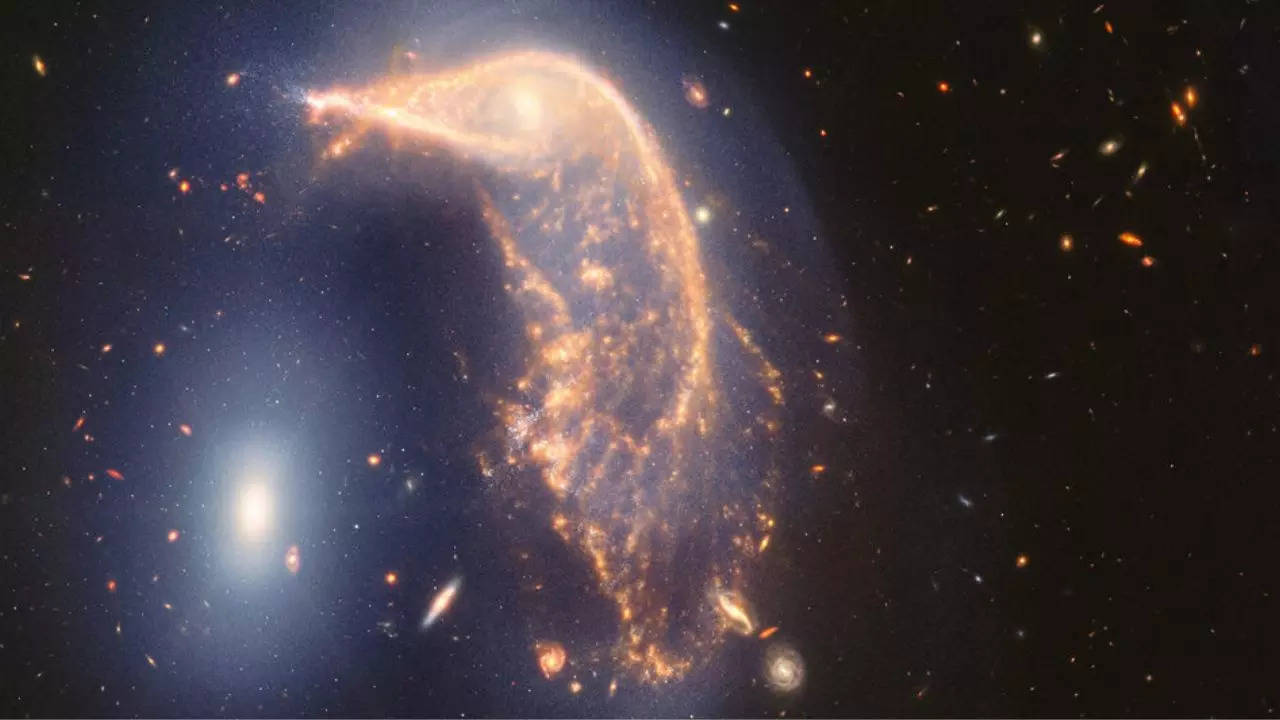The James Webb Space Telescope marked its second anniversary by capturing a beautiful visual of two galaxies interacting with each other. These two galaxies, collectively called Arp 142, are individually cataloged as Penguin (NGC 2936) and the Egg (NGC 2937). The James Webb Telescope, which specializes in capturing infrared light- whose wavelength is beyond the ability of human eyes, shows these two galaxies in a slow cosmic dance.
These two galaxies, which are bound to merge into one a few million years from now, started this interaction between 25 million to 75 million years ago. This motion of shimming and swaying will continue for a long time ahead. The telescope observed a blue haze, made of a mix of stars and gas, that joins the two galaxies.
According to the ESA, the Penguin was once a spiral but today its form has a shadow of a beak, head, backbone, and a fanned-out tail. The galaxy is rich in stars and dust where the gravitational pull makes the thinner areas of gas and dust crash, causing them to form new stars. These newer stars are surrounded by a smoke-like molecule.
Whereas the Egg has always been an elliptical galaxy, full of old stars.
Although the Penguin appears bigger than the Egg, the Egg has not been distorted by the bigger galaxy as they both have similar mass. These two galaxies are 10,000 light years away from each other. And they both are around 336 million light years away from planet Earth.
Since the first image that the James Webb Telescope captured, it has been two long years. It is responsible for constantly capturing the images of our universe and collecting data known as spectra. The technology of this telescope has brought humans closer to exploring every aspect of nature. It is the largest, and most powerful telescope to ever exist in space. James Webb Telescope is an international partnership between countries that include NASA, ESA, and the Canadian Space Agency (CSA).
The achievements of these telescopes are uncountable but to name a few they include- unraveling the mystery of how the Universe was recognised, witnessing the merger of black holes and galaxies, the optimum conditions under which rocky planets are formed, and studying the supernova remnants. Along with that, it has given the world a peek into the mysterious yet spectacularly beautiful universe, by capturing images of supernovas, nebulas, and galaxy clusters.
These two galaxies, which are bound to merge into one a few million years from now, started this interaction between 25 million to 75 million years ago. This motion of shimming and swaying will continue for a long time ahead. The telescope observed a blue haze, made of a mix of stars and gas, that joins the two galaxies.
According to the ESA, the Penguin was once a spiral but today its form has a shadow of a beak, head, backbone, and a fanned-out tail. The galaxy is rich in stars and dust where the gravitational pull makes the thinner areas of gas and dust crash, causing them to form new stars. These newer stars are surrounded by a smoke-like molecule.
Whereas the Egg has always been an elliptical galaxy, full of old stars.
Although the Penguin appears bigger than the Egg, the Egg has not been distorted by the bigger galaxy as they both have similar mass. These two galaxies are 10,000 light years away from each other. And they both are around 336 million light years away from planet Earth.
Since the first image that the James Webb Telescope captured, it has been two long years. It is responsible for constantly capturing the images of our universe and collecting data known as spectra. The technology of this telescope has brought humans closer to exploring every aspect of nature. It is the largest, and most powerful telescope to ever exist in space. James Webb Telescope is an international partnership between countries that include NASA, ESA, and the Canadian Space Agency (CSA).
The achievements of these telescopes are uncountable but to name a few they include- unraveling the mystery of how the Universe was recognised, witnessing the merger of black holes and galaxies, the optimum conditions under which rocky planets are formed, and studying the supernova remnants. Along with that, it has given the world a peek into the mysterious yet spectacularly beautiful universe, by capturing images of supernovas, nebulas, and galaxy clusters.
Denial of responsibility! Swift Telecast is an automatic aggregator of the all world’s media. In each content, the hyperlink to the primary source is specified. All trademarks belong to their rightful owners, all materials to their authors. If you are the owner of the content and do not want us to publish your materials, please contact us by email – swifttelecast.com. The content will be deleted within 24 hours.


